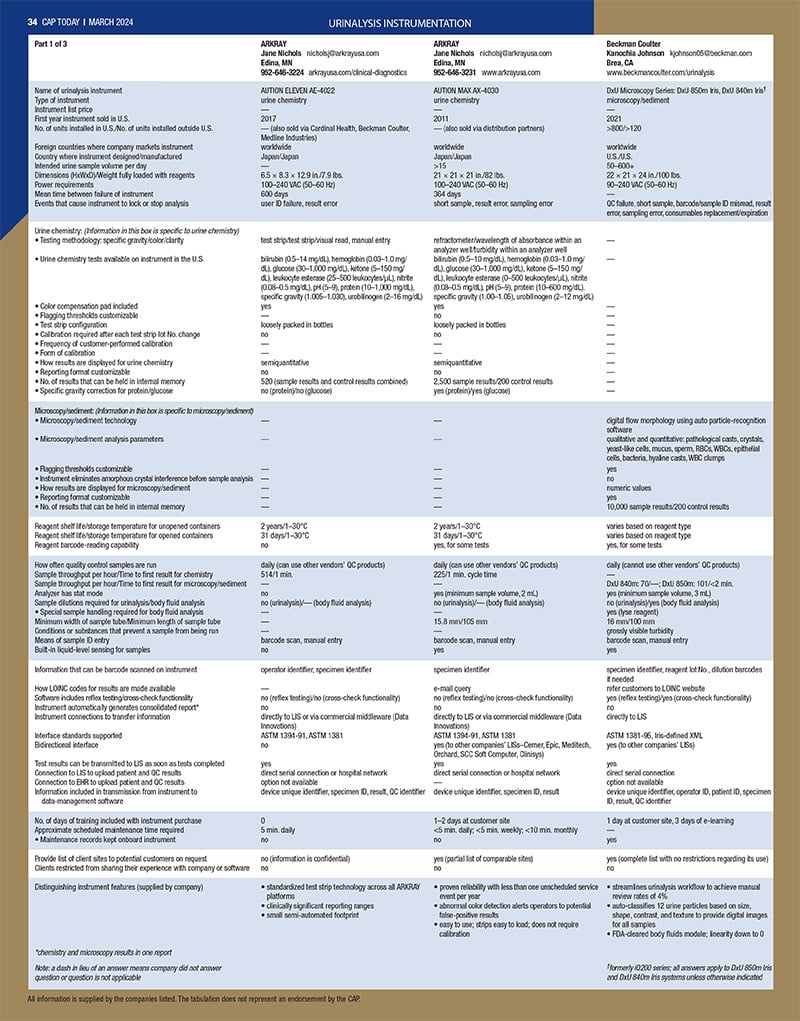Company:
Contact:
Email:
City, State:
Phone:
Website:
Name of urinalysis instrument:
Type of instrument:
Instrument list price:
First year instrument sold in U.S.:
No. of units installed in U.S./No. of units installed outside U.S.:
Foreign countries where company markets instrument:
Country where instrument designed/manufactured:
Intended urine sample volume per day:
Dimensions (HxWxD)/Weight fully loaded with reagents:
Power requirements:
Mean time between failure of instrument:
Events that cause instrument to lock or stop analysis:
Urine chemistry: (Information in this box is specific to urine chemistry):
• Testing methodology: specific gravity/color/clarity:
• Urine chemistry tests available on instrument in the U.S.:
• Color compensation pad included:
• Flagging thresholds customizable:
• Test strip configuration:
• Calibration required after each test strip lot No. change:
• Frequency of customer-performed calibration:
• Form of calibration:
• How results are displayed for urine chemistry:
• Reporting format customizable:
• No. of results that can be held in internal memory:
• Specific gravity correction for protein/glucose:
Microscopy/sediment: (Information in this box is specific to microscopy/sediment):
• Microscopy/sediment technology:
• Microscopy/sediment analysis parameters:
• Flagging thresholds customizable:
• Instrument eliminates amorphous crystal interference before sample analysis:
• How results are displayed for microscopy/sediment:
• Reporting format customizable:
• No. of results that can be held in internal memory:
Reagent shelf life/storage temperature for unopened containers:
Reagent shelf life/storage temperature for opened containers:
Reagent barcode-reading capability:
How often quality control samples are run:
Sample throughput per hour/Time to first result for chemistry:
Sample throughput per hour/Time to first result for microscopy/sediment:
Analyzer has stat mode:
Sample dilutions required for urinalysis/body fluid analysis:
• Special sample handling required for body fluid analysis:
Minimum width of sample tube/Minimum length of sample tube:
Conditions or substances that prevent a sample from being run:
Means of sample ID entry:
Built-in liquid-level sensing for samples:
Information that can be barcode scanned on instrument:
How LOINC codes for results are made available:
Software includes reflex testing/cross-check functionality:
Instrument automatically generates consolidated report*:
Instrument connections to transfer information:
Interface standards supported:
Bidirectional interface:
Test results can be transmitted to LIS as soon as tests completed:
Connection to LIS to upload patient and QC results:
Connection to EHR to upload patient and QC results:
Information included in transmission from instrument to data-management software:
No. of days of training included with instrument purchase:
Approximate scheduled maintenance time required:
• Maintenance records kept onboard instrument:
Provide list of client sites to potential customers on request:
Clients restricted from sharing their experience with company or software:
Distinguishing instrument features (supplied by company):
*chemistry and microscopy results in one report; Note: a dash in lieu of an answer means company did not answer question or question is not applicable:
In urinalysis, compromises, collections, and rules
March 2024—Reflex criteria, middleware, bladder cancer screening, point of care, controls, and collections came up in CAP TODAY’s Jan. 16 roundtable on urinalysis. Six people weighed in, with CAP TODAY publisher Bob McGonnagle leading. Their take on where things stand and where they can be better follows. CAP TODAY’s guide to urinalysis instrumentation begins here.

Dr. Skelton
Tim Skelton, in last year’s urinalysis roundtable we spoke about the need for reflex testing. One of our roundtable participants said that without reflex testing, his laboratory had an unacceptably high rate of false-positive urine cultures. The laboratory adopted reflex testing, and the result was a dramatic improvement in patient care and laboratory efficiency. Is reflex testing a hot topic for you at Lahey?
Timothy Skelton, MD, PhD, medical director, core laboratory and clinical informatics, Lahey Hospital and Medical Center, and medical director, laboratory and pathology informatics, Beth Israel Lahey Health: It is. Two clinical groups with different priorities have competing interests. One is primary care providers and the emergency department. They don’t want to miss any urinary tract infections, and to give them a false-negative is problematic. The other is the infectious disease group and the pharmacy. Their primary interest is antibiotic stewardship. They don’t want to prescribe an antibiotic unless there’s a UTI diagnosis. They have a different opinion about what the reflex criteria should be. So we do the full urinalysis—chemistry and microscopic. Ten to 15 percent of the time we have a negative chemistry dipstick but significant findings on the microscopic—it’s either red cells or white cells and then rarely crystals. We do 100 percent microscopic on all our urinalysis, so we can use the microscopic as our reflex criteria. We have decided on a white blood cell count of 10 per high-power field. If it’s above that, we reflex the urine culture.
Is that the Solomonic lab value that satisfies both ends of your clinical demand?
Dr. Skelton (Beth Israel Lahey Health): It’s a compromise. For a while we required bacteria to be present, but the ED had examples in which there were significant white cells but a bacteria count below the cutoff and the patient was not treated and then found to have a fulminant UTI later. We decided we wouldn’t suppress the reflex based on lack of bacteria.
 CAP TODAY Pathology/Laboratory Medicine/Laboratory Management
CAP TODAY Pathology/Laboratory Medicine/Laboratory Management
